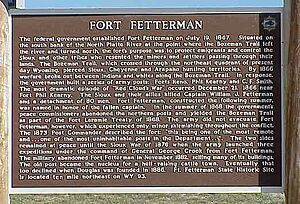Fort Fetterman facts for kids
Quick facts for kids |
|
|
Fort Fetterman
|
|
| Lua error in Module:Location_map at line 420: attempt to index field 'wikibase' (a nil value). | |
| Nearest city | Orpha, Wyoming |
|---|---|
| Area | 70 acres (28 ha) |
| Built | 1867 |
| Architectural style | Log cabin style |
| NRHP reference No. | 69000187 |
| Added to NRHP | April 16, 1969 |
Fort Fetterman was a military fort built in 1867 by the United States Army. It was located on the Great Plains in what was then Dakota Territory, near where Douglas, Wyoming is today. The fort sat high on cliffs overlooking the North Platte River. It was an important base for the army's missions against Native American tribes in the area. Today, Fort Fetterman is recognized as a special historical place on the National Register of Historic Places.
Contents
Building Fort Fetterman
Fort Fetterman was built to be a main supply center for the U.S. Army. Soldiers from the 4th U.S. Infantry started building it on July 19, 1867. Major William E. Dye led these soldiers. The fort was named after Captain William J. Fetterman. He had died in a battle with Native American tribes near Fort Phil Kearny in December 1866.
The fort was quite large for its time. It had living areas for 300 soldiers and their officers. There were also buildings to store ammunition, food, and other supplies. A hospital with 15 beds was available for sick or injured soldiers. The fort also had stables for horses and a corral for many mule wagons. Other buildings included a theater, an ice-house, a root-house, and a granary. There were also shops for blacksmiths, saddlers, and painters. A steam engine helped pump water from the North Platte River.
Fort Fetterman's Location and Importance
After Fort Fetterman was finished, the army closed Fort Caspar. Its soldiers moved to the new fort in August 1867. Fort Fetterman was on the south side of the Platte River. This meant it was not included in the 1868 Treaty of Fort Laramie. This treaty made the U.S. abandon other forts further north. These included Fort Reno, Fort Phil Kearny, and Fort C.F. Smith. Because of this, Fort Fetterman became the northernmost army post in eastern Wyoming. It played a key role in protecting the Bozeman Trail and other paths used by settlers.
Life at the Fort
Life at Fort Fetterman was often tough. Its remote location meant it was not a popular place for soldiers to be stationed. Many soldiers left without permission. Winters were long and very cold. Supplies had to be brought in by wagon from Fort Laramie or from Medicine Bow Station. Soldiers had to carry water up steep hills from the river. The soil was not good for growing vegetables, so fresh food was hard to get.
Major Expeditions and the End of the Fort
In 1876, during the Great Sioux War, things changed. This war involved the Lakota, Cheyenne, and Arapaho tribes. Several big army missions started from Fort Fetterman. The Big Horn Expedition, led by Colonel Joseph J. Reynolds, left in March. It ended in a defeat at the Battle of Powder River. Brigadier General George Crook led the Yellowstone Expedition in June. This group fought in the Battle of Rosebud. Later, Colonel Ranald S. Mackenzie led the Powder River Expedition. They destroyed a Cheyenne village in November during the Dull Knife Fight.
Fort Fetterman stayed active until 1882. By then, the Indian Wars had mostly ended. The army no longer needed the fort and abandoned it.
Fetterman City
After the army left, a small town grew around the empty fort. It was called Fetterman City. People like Charles Henry King started it as a place for ranchers and wagon trains to get supplies. However, in 1886, the town of Douglas was built just eleven miles away. Fetterman City quickly became less important and declined.
Fort Fetterman Today
Over time, the old fort fell into disrepair. Today, parts of it have been restored. It is now listed on the National Register of Historic Places. The State of Wyoming manages it as a historic site. Visitors can walk a special trail to see the remains of the fort's buildings. An officers' quarters and a storage building for weapons have been rebuilt. These buildings now have exhibits, artifacts, and displays about the fort's history. They also tell stories about Fetterman City and the Native American tribes of the area.



